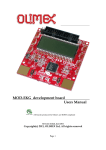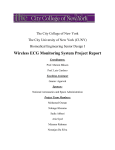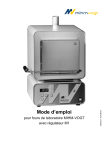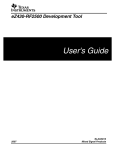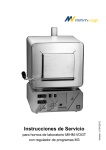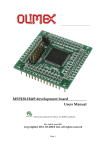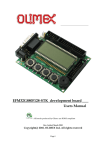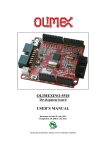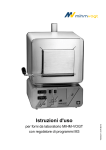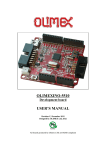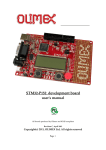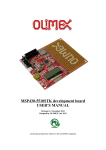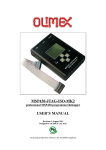Download MOD-PULSE User Manual
Transcript
MOD-PULSE development board Users Manual All boards produced by Olimex are ROHS compliant Revision Initial, March 2011 Copyright(c) 2011, OLIMEX Ltd, All rights reserved Page 1 INTRODUCTION: MOD-PULSE is an instrument for monitoring the blood oxygenation of a human. By measuring the oxygen level and heart rate, MOD-PULSE can display the levels of blood oxygenation and heart rate on it's LCD display. To perform it's functionality, MOD-PULSE requires external sensor connected to it via PROBE connector. MOD-PULSE can be connected to variety of OLIMEX's development boards via it's UEXT connector. BOARD FEATURES: • MCU: MSP430FG439 • JTAG • UEXT • custom LCD • two user buttons • two status leds • power supply switch • +3V lithium battery connector • Battery connector for 2 x 1.5V AA batteries • DB9 – Female connector • System clock crystal • extension pin holes for each microcontroller's ports • FR-4, 1.5 mm, red soldermask, component print • Dimensions: 134.6x101.6mm (5.3 x 4.0") ELECTROSTATIC WARNING: The MOD-PULSE board is shipped in protective anti-static packaging. The board must not be subject to high electrostatic potentials. General practice for working with static sensitive devices should be applied when working with this board. BOARD USE REQUIREMENTS: Cables: The cable you will need depends on the programmer/debugger you use. If you use MSP430-JTAG-TINY, MSP430-JTAG-TINY-V2, or MSP430JTAG-ISO, you will need USB A-B cable. If you use MSP430-JTAG, you will need LPT cable. Page 2 Hardware: Programmer/Debugger MSP430-JTAG, MSP430-JTAGTINY, MSP430-JTAG-TINY-V2, MSP430-JTAG-ISO, or other compatible programming/debugging tool. PROCESSOR FEATURES: MOD-PULSE board uses ultralow power microcontroller MSP430FG439 from Texas Instruments with these features: − Low Supply-Voltage Range, 1.8 V to 3.6 V − Ultralow-Power Consumption: − Active Mode: 300 μA at 1 MHz, 2.2 V − Standby Mode: 1.1 μA − Off Mode (RAM Retention): 0.1 μA − Five Power Saving Modes − Wake-Up From Standby Mode in Less Than 6 μs − 16-Bit RISC Architecture, 125-ns Instruction Cycle Time − Single-Channel Internal DMA − 12-Bit A/D Converter With Internal Reference, Sample-and-Hold and Autoscan Feature − Three Configurable Operational Amplifiers − Dual 12-Bit D/A Converters With Synchronization − 16-Bit Timer_A With Three Capture/Compare Registers − 16-Bit Timer_B With Three Capture/Compare-With-Shadow Registers − On-Chip Comparator − Serial Communication Interface (USART), Select Asynchronous UART or Synchronous SPI by Software − Brownout Detector − Supply Voltage Supervisor/Monitor With Programmable Level Detection − Bootstrap Loader − Serial Onboard Programming, No External Programming Voltage Needed Programmable Code Protection by Security Fuse − Integrated LCD Driver for Up to 128 Segments − 60KB+256B Flash Memory − 2KB RAM Page 3 BLOCK DIAGRAM: Page 4 MEMORY ORGANIZATION: Page 5 1 2 BH14S JTAG 1 3 5 7 9 11 13 RST TDO TDI TMS TCK 1 5 2 6 3 B C817-40 SM D OA0I0 P1.6 P1.5 P1.4 P1.3 P1.2 P1.1 P1.0 GND TDO TDI TMS TCK RST P6.0 P6.1 P6.2 GND GND AVCC 10uF/6.3V 1 2 3 61 62 63 64 65 66 67 68 69 70 71 72 73 74 75 76 77 78 79 80 P1.6/CA0 P1.5/TACLK/ACLK P1.4/TBCLK/SMCLK P1.3/TBOUTH/SVSOUT P1.2/TA1 P1.1/TA0/MCLK P1.0/TA0 XT2OUT XT2IN TDO/TDI TDI TMS TCK RST/NMI P6.0/A0/OA0I0 P6.1/A1/OA0O P6.2/A2/OA0I1 AVSS DVSS1 AVCC 3V-LI_BAT+ -BC-20 01 + Page 6 GND P3.3/UCLK0/S28 P3.4/S27 P3.5/S26 P3.6/S25/DMAE0 P3.7/S24 S23 S22 S21 S20 P2.6/CAOUT/S19 P2.7/ADC12CLK/S18 S17 S16 S15 S14 S13 S12 S11 S10 P4.0/S9 NA 1 2 3 4 REF R12 VEREF+ VREF+ VEREF- NA VCC 40 39 38 37 36 35 34 33 32 31 30 29 28 27 26 25 24 23 22 21 10uF/6.3V C12 P1.7 1 NA 2 NA 3 680k 150k R33 R13 CO M2 S0 4 R11 R26 5 45 C10 6 44 C9 7 43 32768Hz/6pF 8 6 4 2 P3.4 8 6 4 2 9 P3.7 P3.5 UCLK0 SIMO 0 P3.5 10 R10 680k P3.6 11 680k P3.7 12 R9 13 37 100nF 36 S2 NA(HN2X4) 7 5 3 1 PO RT5 NA(HN2X4) R23 COM3 CO M1 S1 8 6 4 2 8 6 4 2 S19 UTXD0 P2.2 P2.0 S3 S5 S7 S9 P6.6 P6.4 P6.2 P6.0 NA(HN2X4) 7 5 3 1 PO RT6 NA(HN2X4) 7 5 3 1 d g a c b C18 100nF UCLK0 P3.4 P3.5 P3.6 P3.7 S23 S22 S21 S20 S19 S18 S17 S16 S15 S14 S13 S12 S11 S10 S9 http://www.olimex.com/dev CO PYRIGHT(C) 2011, O LIMEX Ltd. Rev. B MOD-PULSE P6.7 P6.5 P6.3 P6.1 S2 S4 S6 S8 7 5 3 1 PO RT2 PORT4 7 5 3 1 P3.6 P3.4 SO MI0 P3.0 8 6 4 2 NA(HN2X4) S18 URXD0 P2.3 P2.1 PORT3 P1.6 P1.4 P1.2 P1.0 NA(HN2X4) 7 5 3 1 Extensions S3 NA(0R) 38 R28 39 PO RT1 S22 S23 C11 8 42 8 6 4 2 14 P1.7 P1.5 P1.3 P1.1 15 35 100k 100k S21 34 R7 R8 S20 Q1 P1.7 P2.0 P2.1 P2.2 P2.3 UTXD0 URXD0 G ND VCC R33 R23 R13 R03 COM3 CO M2 CO M1 CO M0 P3.0 SIMO 0 SO MI0 16 MSP430FG 439 60 59 58 57 56 55 54 53 52 51 50 49 48 47 46 45 44 43 42 41 33 U1 P1.7/CA1 P2.0/TA2 P2.1/TB0 P2.2/TB1 P2.3/TB2 P2.4/UTXD0 P2.5/URXD0 DVSS2 DVCC2 P5.7/R33 P5.6/R23 P5.5/R13 R03 P5.4/COM3 P5.3/COM2 P5.2/COM1 COM0 P3.0/STE0/S31 P3.1/SIMO0/S30 P3.2/SOMI0/S29 S9 S10 S11 DVCC1 P6.3/A3/OA1I1/OA1O P6.4/A4/OA1I0 P6.5/A5/OA2I1/OA2O P6.6/A6/DAC0/OA2I0 P6.7/A7/DAC1/SVSIN VREF+ XIN XOUT VEREF+/DAC0 VREF-/VEREFP5.1/S0/A12/DAC1 P5.0/S1/A13 P4.7/S2/A14 P4.6/S3/A15 P4.5/S4 P4.4/S5 P4.3/S6 P4.2/S7 P4.1/S8 S19 17 LCD S18 18 SW 2 41 S1 R29 4.7k S17 19 T1107A(6x3.8x2.5mm) LCD R27 S0 OLIMEX_LTD S16 20 C8 100nF 6 4 S15 21 C7 NA 5 S14 22 T1107A(6x3.8x2.5mm) SW 1 VCC OLIMEX e 24 C6 100nF 4 1 2 3 4 5 6 7 8 9 10 11 12 13 14 15 16 17 18 19 20 2 VCC P6.3 P6.4 P6.5 P6.6 P6.7 VREF+ XIN XO UT VEREF+ VEREFS0 S1 S2 S3 S4 S5 S6 S7 S8 C22 10uF/6.3V NA(0R) NA(0R) 40 0R 23 C5 100nF 0R 48 IS-1390(Default: UEXT is closed) R42 47 COM2 COM3 GYX-SD-TC0805SURK(RED) COM1 W F2S C4 46 100nF COM0 umHF 0R f 32 1k R34 4.7k VEREF+ 31 S8 10nF B C817-40 SM D 1k R33 20R T2 circuit S7 R6 R5 R35 20R T4 T1 30 LED2 R36 4.7k P6.6 T3 Pulsoximeter measurement S6 GYX-SD-TC0805SURK(RED) LED1 VREF+ 100k R38 P6.2 O A0I1 DB9 BFR R37 15k 6 7 8 9 G2 1 2 3 4 5 R32 10k 29 C3 C20 G1PRO BE P6.0 P2.3 28 S5 C2 3 R31 10k VCC S4 1 2 P1.4 P1.5 SOMI0 SIMO0 UCLK0 P3.0 1 O A0O 3.3pF P6.1 P2.2 27 BAT VCC 3 J2 1-2:Open; 2-3:Close 4.7k 470k OA1O 150k P6.3 47pF 25 BAT/UEXT 1 J1 1-2:Open; 2-3:Close C21 R41 OA1I0 P6.4 R40 R39 26 S12 VCC R4 4.7k UTXD0 URXD0 UEXT S13 3.3V_UEXT BH10S R3 4.7k 3.3V_UEXT VCC VCC UEXT-1 UEXT-2 UEXT-3 UEXT-4 UEXT-5 UEXT-6 UEXT-7 UEXT-8 UEXT-9 UEXT-10 10k R2 VCC 2 10nF 2 4 6 8 10 12 14 JTAG BC80 7-40 SM D C1 R1 100k VCC BC80 7-40 SM D POWER SUPPLY HN1x2(Close) 2 1 P_O UT HN1x2(O pen) P_IN SCHEMATIC: BOARD LAYOUT: Page 7 POWER SUPPLY CIRCUIT: MOD-PULSE can take power from: –UEXT connector, when BAT/UEXT switch is in position UEXT. In this case the jumper P_OUT has to be closed. –JTAG, when jumper P_IN is closed. –+3V via BAT connector, when BAT/UEXT switch is in position BAT. In this case the jumper P_OUT has to be closed. –+3V lithium battery via 3V-LI_BAT connector, when BAT/UEXT switch is in position BAT. In this case the jumper P_OUT has to be closed. The programmed board power consumption is about 30 mA with all peripherals enabled. So, we recommend you to supply the board via BAT connector instead of 3V-LI_BAT connector. RESET CIRCUIT: MOD-PULSE reset circuit includes R1 (100k), C1 (10nF), JTAG connector pin 11 and MSP43FG439 pin 74 (RST/NMI). CLOCK CIRCUIT: Quartz crystal Q1 32.768 kHz is connected to MSP430FG439 pin 8 (XIN) and pin 9 (XOUT). JUMPER DESCRIPTION: P_IN When this jumper is closed, the board is power supplied by the standard JTAG pin 2. This is only possible when the consumption of the board is not very high which is typically the case with MSP430 microcontrollers. If this jumper is open the board should be power supplied by another external source. This jumper and P_OUT should always be reversely open/closed, i.e. if P_IN is closed, P_OUT should be open and vice versa. Default state is opened. P_OUT When this jumper is closed, the board is power supplied not by the JTAG but from external source. Then the JTAG has to synchronize with the working voltages which is done through this line. This is especially important when debugging with JTAG. This jumper and P_IN should always be reversely open/closed, i.e. if P_OUT is closed, P_IN should be open and vice versa. Default state is closed. Page 8 J1 When jumper J1 is shorted in position 1-2, UEXT pin 3 is connected to MSP430FG439 pin 55 (P2.4/UTXD0) – signal “UTXD0”. When jumper J1 is shorted in position 2-3, UEXT pin 3 is connected to MSP430FG439 pin 54 (P2.5/URXD0) – signal “URXD0”. Default state is shorted in position 2-3. J2 When jumper J2 is shorted in position 1-2, UEXT pin 4 is connected to MSP430FG439 pin 54 (P2.5/URXD0) – signal “URXD0”. When jumper J2 is shorted in position 2-3, UEXT pin 4 is connected to MSP430FG439 pin 55 (P2.4/UTXD0) – signal “UTXD0”. Default state is shorted in position 2-3. Depending on jumpers J1 and J2 configuration, the board can work in host, or in device mode. The default state of J1 and J2 is for device mode (shorted in position 2-3). INPUT/OUTPUT: Status led with name LED1 (red) connected to MSP430FG439 pin 67 (P1.0/TA0). Status led with name LED2 (red) connected to MSP430FG439 pin 65 (P1.2/TA1). User button with name SW1 connected to MSP430FG439 pin 59 (P2.0/TA2). User button with name SW2 connected to MSP430FG439 pin 58 (P2.1/TB0). Power supply switch with name BAT/UEXT – when in position BAT – the board is power supplied via +3V lithium battery, when is in position UEXT – the board is connected to other board with UEXT and is power supplied by the other board via UEXT connector. LCD custom display. Page 9 EXTERNAL CONNECTORS DESCRIPTION: UEXT: Pin # Signal Name 1 VDD 2 GND 3 TX 4 RX 5 P1.4 6 P1.5 7 SOMI0 8 SIMO0 9 UCLK0 10 P3.0 JTAG: Pin # Signal Name Pin # Signal Name 1 TDO 2 Via P_IN to VCC 3 TDI 4 Via P_OUT to VCC 5 TMS 6 Not Connected 7 TCK 8 Not Connected Page 10 9 GND 10 Not Connected 11 RST 12 Not Connected 13 Not Connected 14 Not Connected PORT1: Pin # Signal Name Pin # Signal Name 1 P1.0 2 P1.1 3 P1.2 4 P1.3 5 P1.4 6 P1.5 7 P1.6 8 P1.7 PORT2: Pin # Signal Name Pin # Signal Name 1 P2.0 2 P2.1 3 P2.2 4 P2.3 5 UTXD0 6 URXD0 7 S19 8 S18 PORT3: Pin # Signal Name Pin # Signal Name 1 P3.0 2 SIMO0 3 SOMI0 4 UCLK0 5 P3.4 6 P3.5 7 P3.6 8 P3.7 Page 11 PORT4: Pin # Signal Name Pin # Signal Name 1 S9 2 S8 3 S7 4 S6 5 S5 6 S4 7 S3 8 S2 PORT5: Pin # Signal Name Pin # Signal Name 1 S1 2 S0 3 COM1 4 COM2 5 COM3 6 R13 7 R23 8 R33 PORT6: Pin # Signal Name Pin # Signal Name 1 P6.0 2 P61 3 P6.2 4 P6.3 5 P6.4 6 P6.5 7 P6.6 8 P6.7 REF: Pin # Signal Name Pin # Signal Name 1 VEREF+ 2 VREF+ 3 VEREF- 4 GND PROBE: Pin # Signal Name Page 12 1 Not Connected 2 Driving line for sensor's infrared and red led 3 Driving line for sensor's infrared and red led 4 Not Connected 5 P6.2 6 Not Connected 7 GND 8 Not Connected 9 P6.0 BAT: Pin # Signal Name 1 to BAT/UEXT switch 2 GND Page 13 MECHANICAL DIMENSIONS: Page 14 AVAILABLE DEMO SOFTWARE: Demonstrates blood oxygenation and heart rate measurement. For this demo you must connect sensor to MOD-PULSE's PROBE connector. –MOD-PULSE_DemoSoft IAR for MSP v4.21 Page 15 ORDER CODE: MOD-PULSE - assembled and tested board How to order? You can order to us directly or by any of our distributors. Check our web www.olimex.com/dev for more info. Revision history: Board's revision: Rev. B, June 2011 Manual's revision: Rev. Initial, June 2011 Page 16 Disclaimer: © 2011 Olimex Ltd. All rights reserved. Olimex®, logo and combinations thereof, are registered trademarks of Olimex Ltd. Other terms and product names may be trademarks of others. The information in this document is provided in connection with Olimex products. No license, express or implied or otherwise, to any intellectual property right is granted by this document or in connection with the sale of Olimex products. Neither the whole nor any part of the information contained in or the product described in this document may be adapted or reproduced in any material from except with the prior written permission of the copyright holder. The product described in this document is subject to continuous development and improvements. All particulars of the product and its use contained in this document are given by OLIMEX in good faith. However all warranties implied or expressed including but not limited to implied warranties of merchantability or fitness for purpose are excluded. This document is intended only to assist the reader in the use of the product. OLIMEX Ltd. shall not be liable for any loss or damage arising from the use of any information in this document or any error or omission in such information or any incorrect use of the product. Page 17

















